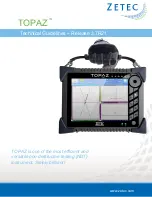
Subject to change without notice
28
The output provides 0.2V
pp
±1% (tr <4ns) for 10:1 probes.
When the Y deflection coefficient is set to 5mV/div, the
calibration voltage corresponds to a vertical display of 4
divisions (10:1 probe).
The output socket has an internal diameter of 4.9mm to
accommodate the internationally accepted shielding tube
diameter of modern Probes and F-series slim line probes.
Only this type of construction ensures the extremely short
ground connections which are essential for an undistorted
waveform reproduction of non-sinusoidal high frequency
signals.
Adjustment at 1kHz
The C-trimmer adjustment (low frequency) compensates the
capacitive loading on the oscilloscope input. By this
adjustment, the capacitive division assumes the same ratio
as the ohmic voltage divider to ensure the same division ratio
for high and low frequencies, as for DC. (For 1:1 probes or
switchable probes set to 1:1, this adjustment is neither
required nor possible). A baseline parallel to the horizontal
graticule lines is essential for accurate probe adjustments.
(See also
“Trace rotation TR”
).
Connect the probes to the
CH I input. Set the deflection coefficient to 5mV/div and the
input coupling to DC. The time deflection coefficient should
be set to 0.2ms/div. All deflection coefficients should be
calibrated. Plug the probe tip into the calibrator output socket.
Approximately 2 complete waveform periods are displayed
on the CRT screen. The compensation trimmer should be
adjusted. The location of the low frequency compensation
trimmer can be found in the probe information sheet. Adjust
the trimmer with the insulated screw driver provided, until
the tops of the square wave signal are exactly parallel to the
horizontal graticule lines (see 1kHz diagram). The signal height
should then be 4div ± 0.16div (= 4% (oscilloscope 3% and
probe 1%). During this adjustment, the signal edges will
remain invisible.
Adjustment at 1MHz
Some probes
incorporate resonance de-emphasing networks (R-trimmer
in conjunction with inductances and capacitors) which permit
probe compensation in the range of the upper frequency limit
of the vertical oscilloscope amplifier. Only this compensative
adjustment ensures optimum utilization of the full bandwidth,
together with constant group delay at the high frequency
end, thereby reducing characteristic transient distortion near
the leading edge (e.g. overshoot, rounding, ringing, holes or
bumps) to an absolute minimum.
Prerequisite for this HF compensation is a square wave
generator with fast rise time (typically 4ns), and low output
impedance (approx. 50
Ω
), providing 0.2V at a frequency of
approx. 1MHz. The calibrator output of this instrument meets
these requirements when the
CAL.
pushbutton is depressed.
Connect the probe to
CH.I
input. Depress the
CAL.
pushbutton for 1MHz. Operate the oscilloscope as described
under 1kHz but select for 0.2µs/div time deflection coefficient
setting.
Insert the probe tip into the output socket. A waveform will
be displayed on the CRT screen, with leading and trailing
edges clearly visible. For the HF-adjustment now to be per-
formed, it will be necessary to observe the rising edge as
well as the upper left corner of the pulse top. The location of
the high frequency compensation trimmer(s) can also be
found in the probe information sheet. These R-trimmer(s)
have to be adjusted such that the beginning of the pulse is
as straight as possible. Overshoot or excessive rounding are
unacceptable. The adjustment is relatively easy if only one
adjusting point is present. In case of several adjusting points
the adjustment is slightly more difficult, but causes a better
result. The rising edge should be as steep as possible, with a
pulse top remaining as straight and horizontal as possible.
After completion of the HF-adjustment, the signal amplitude
displayed on the CRT screen should have the same value as
during the 1kHz adjustment.
Probes other than those mentioned above, normally have a
larger tip diameter and may not fit into the calibrator output.
Whilst it is not difficult for an experienced operator to build a
suitable adapter, it should be pointed out that most of these
probes have a slower rise time with the effect that the total
bandwidth of scope together with probe may fall far below
that of the oscilloscope. Furthermore, the HF-adjustment
feature is nearly always missing so that waveform distortion
can not be entirely excluded. The adjustment sequence must
be followed in the order described, i.e. first at 1kHz, then at
1MHz. The calibrator frequencies should not be used for time
base calibration. The pulse duty cycle deviates from 1:1 ratio.
Prerequisites for precise and easy probe adjustments, as well
as checks of deflection coefficients, are straight horizontal
pulse tops, calibrated pulse amplitude, and zero-potential at
the pulse base. Frequency and duty cycle are relatively un-
critical. For interpretation of transient response, fast pulse
rise times and low-impedance generator outputs are of
particular importance. Providing these essential features, as
well as switch-selectable output-frequencies, the calibrator
of the instrument can, under certain conditions, replace
expensive square wave generators when testing or
compensating wide-band attenuators or -amplifiers. In such
a case, the input of an appropriate circuit will be connected
to the
CAL.
-output via a suitable probe.
The voltage provided at a high-impedance input (1M
Ω
II 15-
30pF) will correspond to the division ratio of the probe used
(10:1 = 20mVpp output).
Operating modes of the vertical
amplifiers in Yt mode
The most important controls regarding the operation modes
of the vertical amplifiers are the pushbuttons:
CHI (22), DUAL
(23) and CH II (26)
. Their functions are described in the
section
“ Controls and Readout”
.
First Time Operation















































